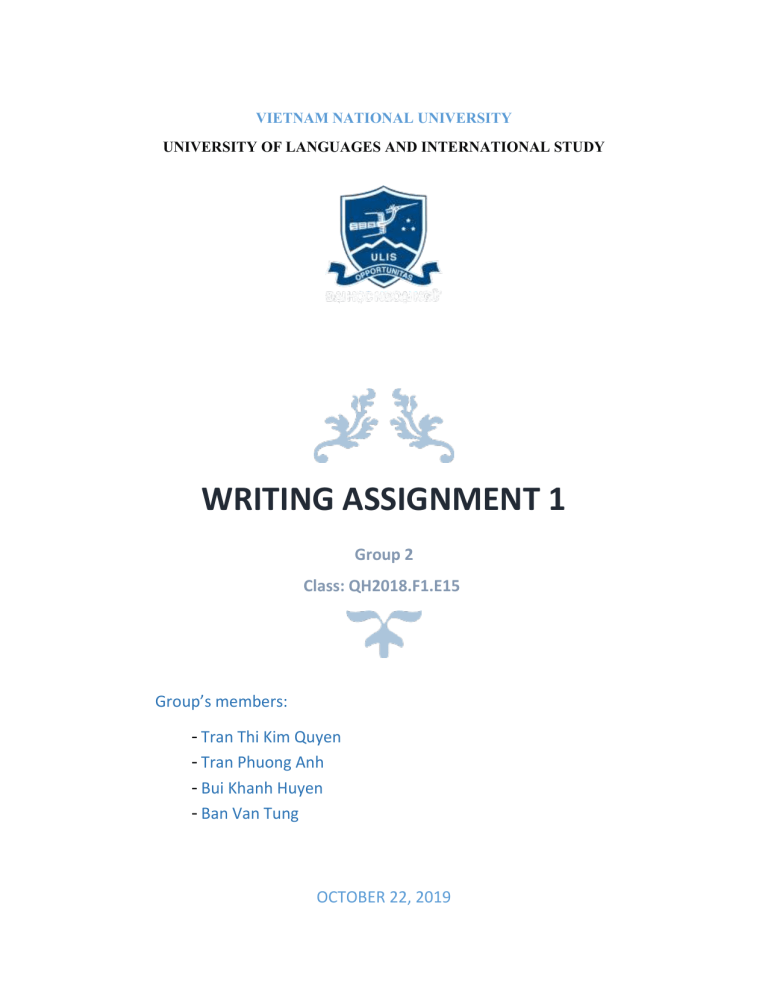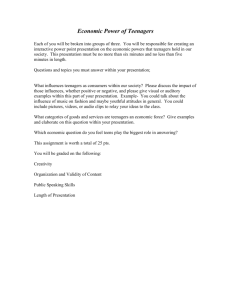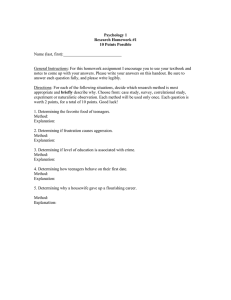
VIETNAM NATIONAL UNIVERSITY UNIVERSITY OF LANGUAGES AND INTERNATIONAL STUDY WRITING ASSIGNMENT 1 Group 2 Class: QH2018.F1.E15 Group’s members: - Tran Thi Kim Quyen - Tran Phuong Anh - Bui Khanh Huyen - Ban Van Tung OCTOBER 22, 2019 Writing Assignment 1 Topic: Compare the influence of family and friends on teenagers. Adolescence, transition from children to adults, is the sensitive period with a variety of mental and physical changes. It is undeniable that teenagers are susceptible by surroundings during their transition, particularly their family and friends. Obviously, how juveniles are influenced by parents and peers is expressed differently in terms of behavior and emotion. Family’s involvement is a fundamental component of teenagers’ behavior and emotional support. Parents play a vital role in setting an example to their children regarding conduct. Teens are highly motivated to be well-behaved when being provided with a healthy home environment. To illustrate, Bandura (1977, as cited in McLeod, 2016) claimed that youths’ behavior development is based on the observation and modeling on parent’s behavior. Conceivably, if parents have standard manners, their children will imitate and behave in an appropriate way; contrarily, juveniles probably display unacceptable behavior when their parents have bad habits such as smoking or drinking. Additionally, family has profound effects on teenagers’ emotion. Being the first socializing agents that teens are exposed, parents are a dominant element in providing emotional nourishment; in other words, they lay a secure foundation for their children’s emotive development. It was claimed that teenagers growing with emotional attachment to their parents have a better chance of fostering harmonious and positive relationships with others in their lives (Guzman, 2007). Moreover, the author also indicated juveniles are more negotiated with parents than rejected because of their greater cognitive and emotional maturity. Thus, when they are in mutual-understanding stage, youngsters are more likely to confide as well as obtain unconditional love and emotive support from their parents. Apart from family, friends’ influence is also remarkable regarding behavior and emotion. Behavior is the crucial factor contributing to the magnitude of peers’ impact. It is apparent that the assembled companions can stimulate socially desirable performance. Berndt and Murphy (2002) scrutinized how the young’s attitudes, behavior and achievement in school were influenced those of their friends. Their 1 findings reflected two types of changes over time in youngsters’ behavior. Specifically, teens whose friends having high disruptive behavior may increase their deviant behavior; yet those who originally have peers with exemplary behavior considerably declined their improper conduct. Lastly, with reference to emotional support, friend have great impacts which are socially two-sided on adolescents. Monroe (2018) considered that peer pressure may encourage negative thoughts leading to a multitude of unwise decisions. In particular, due to their inconsiderable psychology, teens seem to easily adapt to new elements that make them feel contented. For this reason, teenagers are mentally vulnerable to social problems like drinking or drugs. On the other hand, emotional support from friends has its positivity. It forms an environment in which teenagers share their current state and have the feeling of being accepted, empathized and understood (Elisabeth, 2014). Hence, this is probably considered as a mental therapy that helps adolescents cope with isolation or depression. In conclusion, parents and friends have a substantial influence on the behavior and emotion of youngsters. The attention of parents to their children basically reflects the formation of social norms and emotive basis. Friends, in contrast, sway teenagers more in social perspectives including either benefits or disadvantages. Nevertheless, it is indisputable that adolescents are the one who come to final decisions in any circumstances. 2 References Berndt, T. J., & Murphy, L. M. (2002). Influences of Friends and Friendships: Myths, Truths and Research Recommendations [PDF fỉle]. Retrieved from http://citeseerx.ist.psu.edu/viewdoc/download?doi=10.1.1.505.6445&rep=r ep1&type=pdf Elisabeth G. (2014). Peer Support for Student Mental Health [PDF file]. Retrieved from https://www.studentminds.org.uk/uploads/3/7/8/4/3784584/peer_support_f or_student_mental_health.pdf Guzman, M. R. T. (2007, Aug). Friendships, Peer Influence And Peer Pressure During The Teen Years. Neb Guide, (2007). Retrieved from http://extensionpublications.unl.edu/assets/html/g1751/build/g1751.htm McLeod, S. (2008, Feb). Bandura | Social Learning Theory. Retrieved from https://www.simplypsychology.org/bandura.html Monroe, H. S. (2018, Sep). Adolescent Friendships and Relationships: When Parents Should Step In. Retrieved from https://health.usnews.com/healthcare/for-better/articles/2018-09-10/adolescent-friendships-andrelationships-when-parents-should-step-in 3





